From Byzantium to. Monselice: the overcoming of Byzantine art seen through the Madonnas of Milk
While wandering around the halls of Monselice Castle yesterday as part of our #villeinblue press tour, we came across a fresco depicting a Madonna of milk (i.e. depicted in the act of suckling Baby Jesus: this type of representation is also known by its Latin name Madonna lactans) together with two angels. We offer it to you in the image below: the quality is not excellent because unfortunately inside the rooms we were strictly forbidden to take photographs, despite the fact that we were there with the specific aim of introducing our audience to the castle, so in the absence of images available on the web, we had to retrieve a frame of a video on the castle’s YouTube channel. Photographic vicissitudes aside, we come to the painting, a 15th-century work, probably from the Umbrian or Marche area. It is certainly not a masterpiece: the wide robes completely conceal the perception of the bodies they cover (in particular, those of the angels are completely off: they look like two ghosts, rather than two kneeling figures), the left leg of the Madonna is in an unnatural position, the hands of both the Madonna and the Child are disproportionate, and so on.
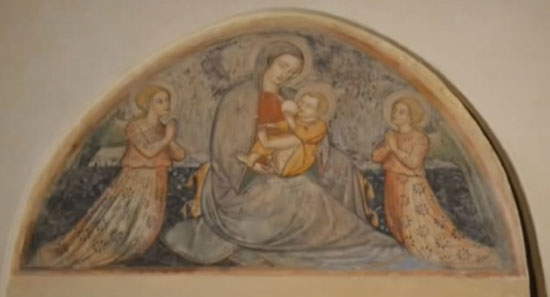 |
| Umbrian-Marchigiano ambit, Madonna del Latte (15th century; Monselice Castle, Romanesque House) |
When we were stopping in front of the work, Pamela from A blonde around the world, who like us was participating in the trip, asked me an interesting question: why does the Child assume that strange pose, with his hand touching his foot? Is there any particular symbolism behind the gesture? Well, let’s start with the answer: there is no strange symbolism, and the pose simply attempts to mimic the movements of an ordinary newborn baby, teasing as best he can while receiving milk from his mother. The question is interesting for the reason that. to be able to give this answer one has to go back in art history more than two hundred years.... ! For while it may seem obvious to us contemporary observers that a child should be depicted in such a way that it appears to us as a real child, in ancient times things were not quite like that. The Monselice fresco is the result of a process that began in the mid-thirteenth century (and, incidentally, it is not even one of the best fruits: but that, probably, was already understood.... !).
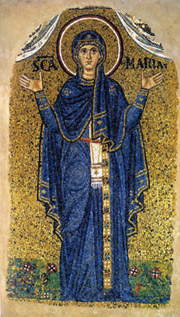 |
| Madonna Orante (12th century; Ravenna, Museo Arcivescovile) |
What exactly happens in the mid-13th century? One of the most radical revolutions in art history takes place: the overcoming of Byzantine art. Until the mid-13th century, in fact, Byzantine art was the main point of reference for all artists working on Italian soil: iconographies, modes and techniques were all derived from the art that was produced in the Eastern Roman Empire, of which Constantinople (ancient Byzantium) was the capital. Trivializing, we can say that Byzantine art reflected the characteristics of the Christianity practiced there: a Christianity devoted to mysticism, asceticism and contemplation. Consequently, Byzantine art was marked by a fierce hieraticism: it must have appeared clear that the divine figures inhabited the heavens and were therefore completely divorced from any kind of tangible reality. An image will better clarify these aspects: here on the left we propose a Praying Madonna (i.e., praying) from the 12th century. This is a mosaic preserved in the Archiepiscopal Museum in Ravenna.
| Icon of St. Mary of Maniace (12th century; Maniace, Abbey of St. Mary of Maniace) |
Our type, that of the “Madonna of Milk,” or Galaktotrophousa (a Greek word meaning “she who nourishes with milk”), began to spread precisely in the 12th century: the icon of St. Mary of Maniace, for example, dates from this period, a panel found in the Sicilian abbey of the same name (in Maniace, in the province of Catania). It is one of the earliest examples of a Galaktotrophousa Madonna of undoubtedly Byzantine production that we have in Italy. This type of Madonna, along with other more “human” types such as the Eleusinian Madonna (“merciful,” a type of depiction in which the Madonna and Child gently brush against each other) experienced rapid success in the regions of the Eastern Empire when, under the reigns of the Comnenian dynasty, which lasted through most of the 1100s, a rapprochement with Western European culture occurred: one of the reflections this rapprochement had on art was precisely to introduce motifs of greater patheticism and sentimentality into Byzantine art. Madonnas, Christs and saints were, however, still far from appearing as men and women rather than as deities. And this “remoteness” of the characters of religion from the faithful, though less profound, in an Italy in which the figurative arts (especially painting) suffered strong Byzantine influences, survived, as we said, until at least the middle of the thirteenth century. We can cite, as an example, the Madonna della Catena of the church of San Silvestro al Quirinale in Rome, a Galaktotrophousa Madonna characterized by a strong sense of solemnity: even, the Child appears in the act of blessing, as in the most hieratic Byzantine tradition. Nothing could be further from how a real, “human” child should be depicted.
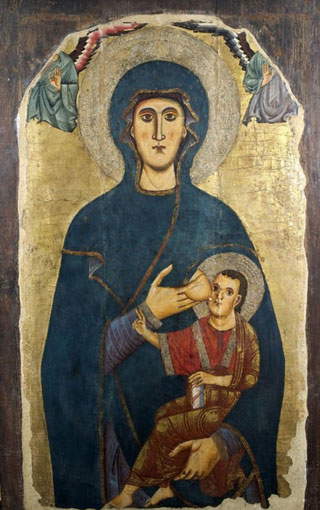 |
| Roman ambit, Madonna of the Chain (ca. 1230-1250; Rome, San Silvestro al Quirinale) |
Things changed when, on the one hand, a more popular and less contemplative religious sentiment began to spread and, on the other hand, sculptors rediscovered classical art and began to receive the influences of French Gothic sculpture, which was particularly marked by the representation of feelings and was among the first medieval art forms to disengage from an essentially mystical vision as Byzantine art was: painting, which in the Middle Ages was always “behind” on novelties compared to sculpture, began to adapt. At first it was the representations of Christ on the cross that were charged with a drama unknown to Byzantine art. Later, it was the turn of the Madonnas with Child who, from Cimabue onward, would begin a slow process that would make them sweeter, more delicate, sentimental, and affectionate, and would make their features more realistic. One of the earliest examples of these new Madonnas of Milk is the one preserved in the Galleria dell’Accademia in Florence, made by the Florentine painter Grifo di Tancredi, a painter particularly receptive to the innovations introduced by Giotto, who as we know was the author of the most radical renewal, in a naturalistic sense, of Italian art of the time: we are around 1300 and, as we can clearly see from the image, the Madonna shows us a beautiful smile, and the Child begins to fidget by giving small kicks with his legs.
 |
| Grifo di Tancredi, Madonna del Latte (c. 1300; Florence, Galleria dell’Accademia) |
As the years went by, Madonnas of Milk (and Madonnas in general) took on a greater humanity: an interesting example is Ambrogio Lorenzetti ’s Madonna lactans preserved in the Palazzo Vescovile in Siena, a work made roughly between 1320 and 1325. Finally, to return to the example of the Madonna of Monselice, we can propose a fine Madonna del Latte, preserved at the Metropolitan Museum in New York, by the Sienese painter Paolo di Giovanni Fei, painted in the 1370s: Siena, compared to Florence, always remained more connected to Byzantine elegance, and it is on the basis of these connections that we can explain the Madonna’s impassive, fixed-forward gaze. But the Child is much less impassive. And her gesture is identical to that of the Madonna of Milk in Monselice! Art has thus been renewed: from now on, artists intent on providing realistic depictions of their characters will increasingly try to reproduce the Infant Jesus as naturally as possible.
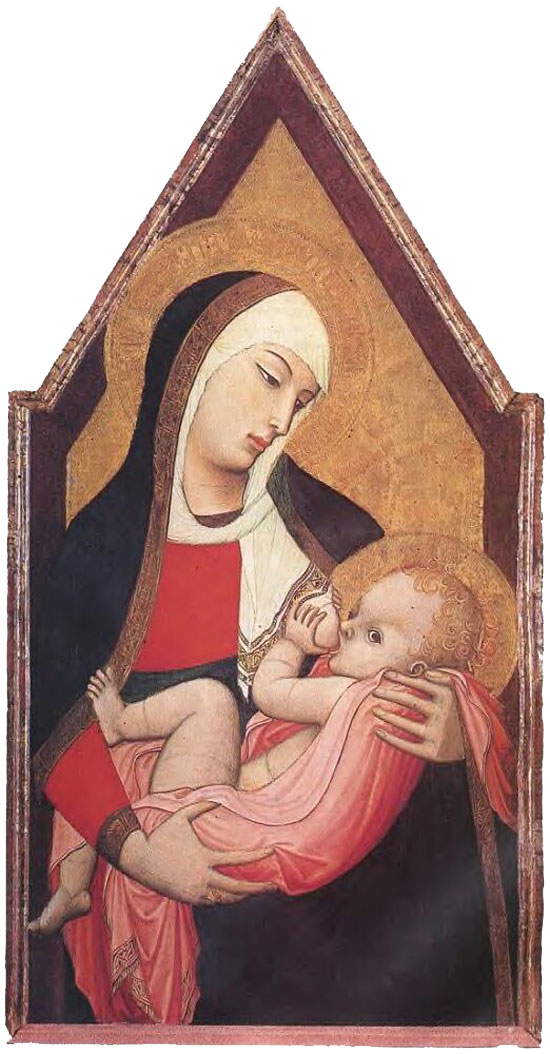 |
| Ambrogio Lorenzetti, Madonna of Milk (c. 1320-1325; New York, Metropolitan Museum) |
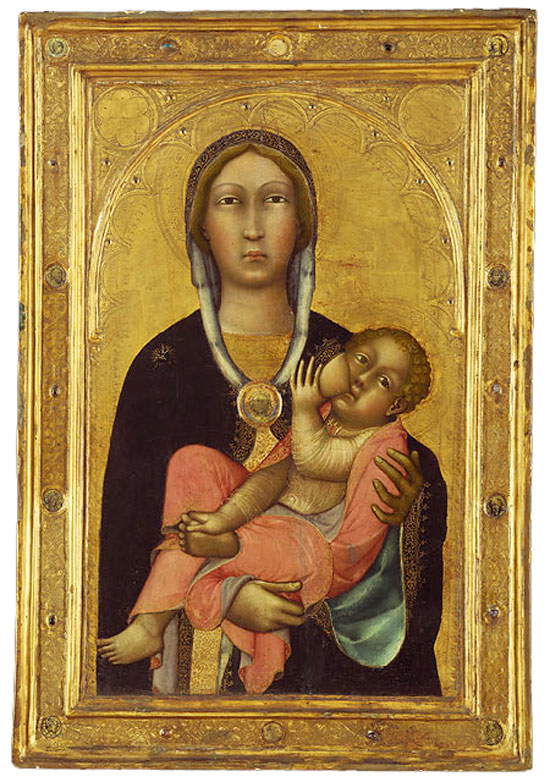 |
| Paolo di Giovanni Fei, Madonna of Milk (c. 1370-1380; New York, Metropolitan Museum). For those reading us from the desktop version: we have tried to reproduce as faithfully as possible the proportions of the two paintings in comparison. |
Warning: the translation into English of the original Italian article was created using automatic tools. We undertake to review all articles, but we do not guarantee the total absence of inaccuracies in the translation due to the program. You can find the original by clicking on the ITA button. If you find any mistake,please contact us.





























